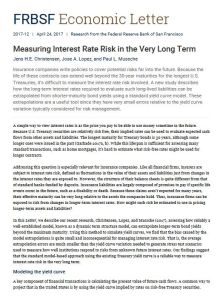Join getAbstract to access the summary!

Join getAbstract to access the summary!
Jens H.E. Christensen, Jose A. Lopez and Paul L. Mussche
Measuring Interest Rate Risk in the Very Long Term
FRBSF, 2017
What's inside?
How financial professionals can price assets and liabilities that extend far into the future.
Recommendation
Judging interest rates and pricing financial instruments can challenge even the savviest professional, but determining how to adequately price risk that extends 50 years and beyond is a real conundrum. In some cases, the benchmark 30-year US Treasury bond may be insufficient. Economists Jens H.E. Christensen, Jose A. Lopez and Paul L. Mussche contend that insurers, traders and bankers can gauge interest rate risk beyond 30-year timelines through “extrapolation.” getAbstract suggests this complex yet illuminating report to insurance professionals and financial experts interested in the pricing dynamics of interest rates.
Summary
About the Authors
Jens H. E. Christensen, Jose A. Lopez and Paul L. Mussche are researchers at the Federal Reserve of San Francisco.


















Comment on this summary